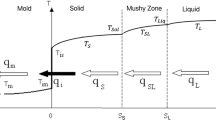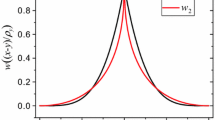Abstract
Galerkin finite element methods are presented for calculation of the dynamic transitions between planar and deep two-dimensional cellular interface morphologies in directional solidification of a binary alloy from models that include solute transport, the phase diagram, and the interfacial free energy between melt and crystals. The unknown melt-solid interface shape is accounted for in the finite element formulation by mapping the equations to a fixed domain. Novel nonorthogonal transformations are introduced combining cylindrical and Cartesian coordinate interface representations for approximating the deep cellular interfaces that evolve from a planar solidification front. The algorithm for time integration combines a fully implicit Adams-Moulton algorithm with the Isotherm-Newton method for solving the nonlinear set of differential-algebraic equations that result from the spatial discretization of the moving-boundary problem. The fully implicit scheme is found to be more accurate and efficient than an explicit predictor-corrector algorithm. Sample calculations show the connectivity between families of shapes with resonant spatial wavelengths.
Similar content being viewed by others
References
Adornato, P. M., and Brown, R. A. (1987). Petrov-Galerkin methods for natural convection in directional solidification of binary alloys,Int. J. Numer. Methods Fluids 7, 761–791.
Brown, R. A. (1980). Finite element methods for calculation of capillary surfaces,J. Computat. Phys. 33, 217–235.
Chang, C. J., and Brown, R. A. (1984). Natural convection in steady solidification: Finite element analysis of a two-phase Rayleigh-Benard problem,J. Computat. Phys. 53, 1–27.
Derby, J. J., and Brown, R. A. (1986). A fully implicit method for simulation of the onedimensional solidification of a non-dilute binary alloy,Chem. Eng. Sci. 41, 37–46.
Derby, J. J., Atherton, L. J., Thomas, P. D., and Brown, R. A. (1987). Finite element methods for analysis of the dynamics and control of Czochralski crystal growth,J. Sci. Comput. 2, 297–343.
Duda, L. J., Malone, M. F., Notter, R. H., and Vrentas, J. S. (1975).Int. J. Heat Mass Transfer 18, 901.
Ettouney, H. M., and Brown, R. A. (1983). Finite element methods for steady solidification problems,J. Computat. Phys. 49, 118–150.
Gresho, P. M., Lee, R. L., and Sani, R. L. (1980). On the time dependent solution of the incompressible Navier-Stokes equations in two and three dimensions, inRecent Advances in Numerical Methods in Fluids, Taylor and Morgan (eds.), Pineridge Press, Swansea, U.K.
Hume, E. C., III, Deen, W. M., and Brown, R. A. (1985). Comparison of boundary and finite element methods for solution of moving-boundary problems governed by a potential,Int. J. Numer. Methods Eng. 21, 1295–1314.
Keller, H. B. (1977). Numerical solution of bifurcation and nonlinear eigenvalue problems, inApplications of Bifurcation Theory, Rabinowitz, P. H. (ed.), Academic Press, New York, pp. 359–384.
Kerszberg, M. (1983). Pattern emergence and selection in crystal growth,Phys. Rev. B 27, 3909–3912.
Kheshgi, H. S., and Scriven, L. E. (1983). Penalty finite element analysis of time dependent two-dimensional free-surface film flow, inFinite Elements in Fluids, Vol. 5, J. T. Odenet at. (eds.), Wiley, New York.
Lynch, D. R. (1982). Unified approach to simulation of deforming elements with application to phase change problems,J. Computat. Phys. 47, 387–411.
Lynch, D. R., and Sullivan, J. M. (1985). Heat conservation in deforming element phase change simulation,J. Computat. Phys. 57, 303–317.
McFadden, G. B., and Coriell, S. R. (1984). Nonplanar interface morphologies during unidirectional solidification of binary alloys,Physica D 12, 253–261.
Meiron, D. I. (1986). Selection of steady-states in the two-dimensional symmetric model of dendritic growth,Phys. Rev. A 33, 2704–2715.
Mittelman, H. D. (1977). On the approximation of capillary surfaces in a gravitational field,Computing 18, 141–148.
Mullins, W. W., and Sekerka, R. F. (1964). Stability of a planar interface during solidification of a dilute binary alloy,J. Appl. Phys. 35, 444–451.
Petzold, L. R. (1982a). Sandia National Laboratories report No. SAND 82-8637.
Petzold, L. R. (1982b). Differential-algebraic equations are not ODEs,SIAM J. Stat. Comput. 3, 367–384.
Ramprasad, N., Bennett, M. J., and Brown, R. A. (1988). Wavelength dependence of cells of finite depth in directional solidification,Phys. Rev. B 38, 583–592.
Saito, H. L., and Scriven, L. E. (1981). Study of coating flow by the finite element method,J. Computat. Phys. 42, 53–76.
Sullivan, J. M., Jr. (1987). Finite element simulation of planar instabilities during solidification of an undercooled melt,J. Computat. Phys. 69, 81–111.
Thomas, P. D., and Brown, R. A. (1987).LU decomposition of banded matrices with augmented dense constraints,Int. J. Numer. Methods Eng. 24, 1451–1459.
Trivedi, R. (1984). Interdendritic spacing: Part II: A comparison of theory and experiment,Met. Trans. 15A, 977–982.
Tsai, H. L., and Rubinsky, B. (1984). A front tracking finite element study on change of phase interface stability during solidification processes in solutions,J. Crystal Growth 70, 56–63.
Ungar, L. H., and Brown, R. A. (1982). The dependence of the shape and stability of rotating captive drops on multiple parameters,Phil. Trans. R. Soc. London 301A, 457–480.
Ungar, L. H., and Brown, R. A. (1984). Cellular interface morphologies in directional solidifications, 1. The one-sided model,Phys. Rev. B 29, 1367–1380 (1984).
Ungar, L. H., and Brown, R. A. (1985). Cellular interface morphologies in directional solidification. 4. The formation of deep cells,Phys. Rev. B 31, 5931–5940.
Ungar, L. H., Bennett, M. J., and Brown, R. A. (1985). Cellular interface morphologies in directional solidification. 3. The effect of coupled heat transfer,Phys. Rev. B 31, 5923–5930.
Wheeler, A. A. (1987). A numerical scheme to model the morphological stability of a freezing binary alloy;J. Appl. Mech. 39, 381–401.
Wollkind, D., and Segel, L. (1970). A nonlinear stability analysis of the freezing of a dilute binary alloy,Phil. Trans. R. Soc. London A268, 351–380.
Yamaguchi, Y., Chang, C. J., and Brown, R. A. (1984). Multiple buoyancy-driven flows in a cylinder heated from below,Phil. Trans. R. Soc. London 312A, 519–552 (1984).
Author information
Authors and Affiliations
Rights and permissions
About this article
Cite this article
Ungar, L.H., Ramprasad, N. & Brown, R.A. Finite element methods for unsteady solidification problems arising in prediction of morphological structure. J Sci Comput 3, 77–108 (1988). https://doi.org/10.1007/BF01066483
Received:
Issue Date:
DOI: https://doi.org/10.1007/BF01066483




